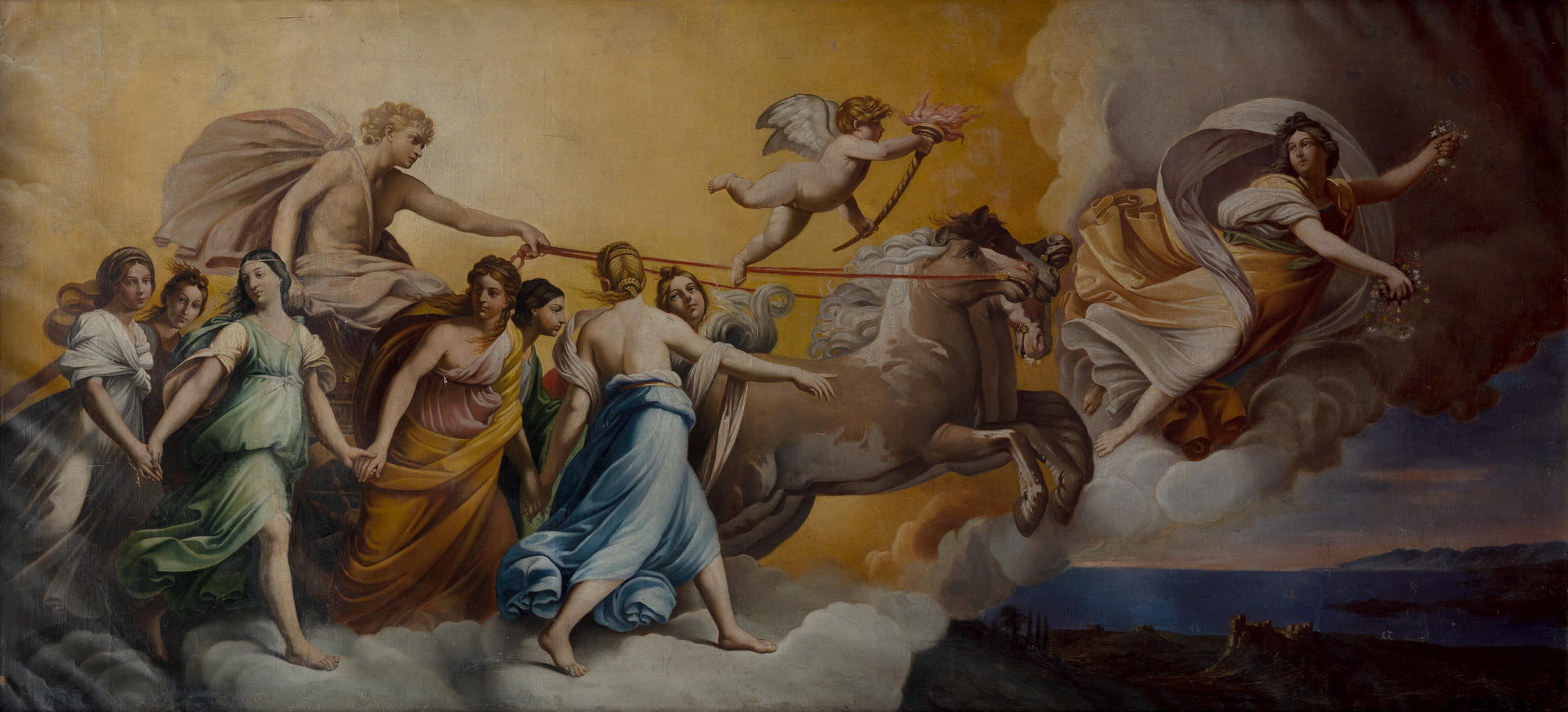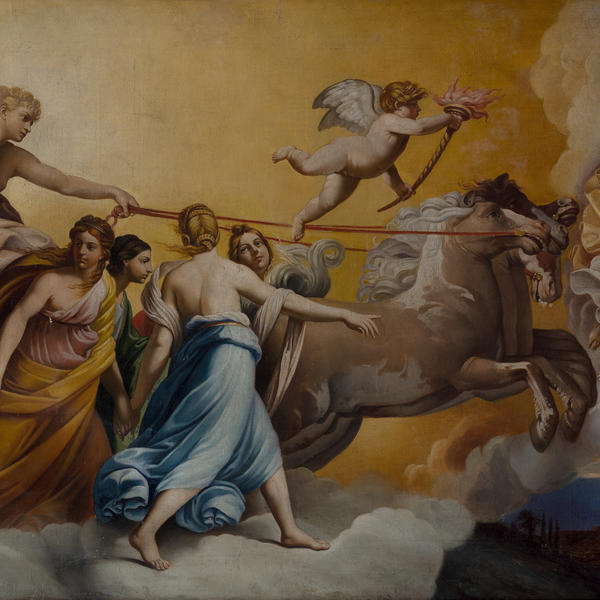The painting from the collection of the Tyumen Museum and Educational Society is a copy of the fresco which is painted on the ceiling of Palazzo Rospigliosi in Rome. The fresco was created by a famous painter of the 16th century Guido Reni.
Guido Reni influenced European art greatly, especially late Baroque style. His paintings were often imitated by the painters of the ensuing 17-19th centuries. Guido Reni considered to be one of the greatest representatives of the Bolognese School of Art, which also included such painters as Ludovico Carracci, Denys Calvaert, Lavinia Fontana, Domenichino and others. The Bolognese School differed in expressiveness and expression of images. The followers of this School painted on mythological and religious subjects and heroic scenes.
Guido Reni was born on the 4th of November 1575 in Bologna in the family of musicians. When he was nine, he was apprenticed to study art to the Flemish painter Denys Calvaert. At the age of twenty Guido Reni together with three other students of this workshop migrated to Ludovico Carracci to the Accademia degli Incamminati.
“Academy for those who are making progress"- that was how this educational institution was called — was founded in 1582 and is one of the best in Italy. This place allowed painters to become creators and not just ordinary craftsmen as it had been before. Guido attended Academy till 1598 until he had a quarel with professor Carracci. Several years after that Guido Reni moved to Rome. There he worked with Annibale Carracci, a cousin of his teacher. Together they painted with frescoes Palazzo Farnese, one of the important cultural sites of the High Renaissance in Rome. Reni became one of the main painters in the period from 1607-1614, when the Pope Paul V was in power.
In art researchers' opinion, fresco Aurora is one of the best works of Reni. This painting was commissioned by Cardinal Scipione Borghese. The Cardinal wanted to adorn with it his palace, the construction of which began in 1611.In 1616 without waiting for the end of the construction, Borghese had sold this palace, which having changed several owners, at last, became the property of Rospigliosi-Pallavicini family. This family still owns the palace. On certain days the visitors are allowed there to look at the famous Reni’s fresco.
The copy of the fresco was painted by an unknown artist a little bit later. The composition is full of movement and light grace, showing the play of light and plastic of figures. All the characters are located in nearly the same flatness as on the ancient reliefs. They are painted with the elegance which is a distinguishing feature of Reni’s creative work.
Guido Reni influenced European art greatly, especially late Baroque style. His paintings were often imitated by the painters of the ensuing 17-19th centuries. Guido Reni considered to be one of the greatest representatives of the Bolognese School of Art, which also included such painters as Ludovico Carracci, Denys Calvaert, Lavinia Fontana, Domenichino and others. The Bolognese School differed in expressiveness and expression of images. The followers of this School painted on mythological and religious subjects and heroic scenes.
Guido Reni was born on the 4th of November 1575 in Bologna in the family of musicians. When he was nine, he was apprenticed to study art to the Flemish painter Denys Calvaert. At the age of twenty Guido Reni together with three other students of this workshop migrated to Ludovico Carracci to the Accademia degli Incamminati.
“Academy for those who are making progress"- that was how this educational institution was called — was founded in 1582 and is one of the best in Italy. This place allowed painters to become creators and not just ordinary craftsmen as it had been before. Guido attended Academy till 1598 until he had a quarel with professor Carracci. Several years after that Guido Reni moved to Rome. There he worked with Annibale Carracci, a cousin of his teacher. Together they painted with frescoes Palazzo Farnese, one of the important cultural sites of the High Renaissance in Rome. Reni became one of the main painters in the period from 1607-1614, when the Pope Paul V was in power.
In art researchers' opinion, fresco Aurora is one of the best works of Reni. This painting was commissioned by Cardinal Scipione Borghese. The Cardinal wanted to adorn with it his palace, the construction of which began in 1611.In 1616 without waiting for the end of the construction, Borghese had sold this palace, which having changed several owners, at last, became the property of Rospigliosi-Pallavicini family. This family still owns the palace. On certain days the visitors are allowed there to look at the famous Reni’s fresco.
The copy of the fresco was painted by an unknown artist a little bit later. The composition is full of movement and light grace, showing the play of light and plastic of figures. All the characters are located in nearly the same flatness as on the ancient reliefs. They are painted with the elegance which is a distinguishing feature of Reni’s creative work.



